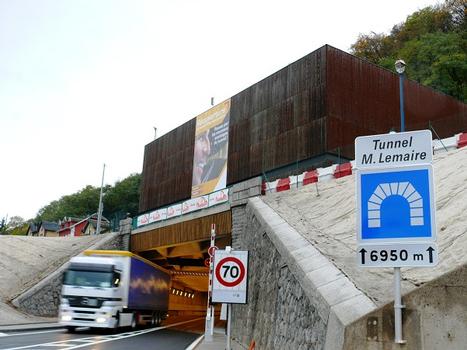General Information
| Other name(s): | Tunnel ferroviaire de Sainte-Marie-aux-Mines |
|---|---|
| Completion: | 1937 |
| Status: | in use |
Project Type
| Structure: |
Tunnel |
|---|---|
| Function / usage: |
original use: Railroad (railway) tunnel current use: Road tunnel |
Location
| Location: |
Sainte-Marie-aux-Mines, Haut-Rhin (68), Grand-Est, France Lusse, Vosges (88), Grand-Est, France |
|---|---|
| Coordinates: | 48° 16' 4" N 7° 9' 29" E |
Technical Information
Dimensions
| Initial construction | ||
|---|---|---|
| tunnel | length | 6 950 m |
| Security updating works | ||
| security tunnel | length | 6 500 m |
| TBM | length | 28 m |
| weight | 900 t | |
| bore diameter | 6 m | |
| length of backup train | 250 m | |
Chronology
| 1937 | Completed and used as railroad tunnel. |
|---|---|
| 1973 — 1976 | Transformed into a road tunnel. |
| 19 April 2004 — 2007 | Renovation works to increase security in the tunnel. Estimated costs: 180 million euros of which 108 million are slated for the construction of a security access tunnel of 5.20 meters in diameter and located parallel to the existing tunnel as well as works in the existing tunnel. |
Notes
This is the longest road tunnel located entirely on French territory.
Excerpt from Wikipedia
The Tunnel Maurice-Lemaire, commonly known as the Tunnel de Sainte-Marie-aux-Mines is a former rail tunnel adapted to permit road traffic to drive between Sainte-Marie-aux-Mines (Haut-Rhin, Alsace) and Saint-Dié (Vosges, Lorraine) without needing to drive over the top of a mountain pass. The tunnel is 6,950 m (7,600 yd) long, which till 2011 made it the longest road tunnel wholly within France. The tunnel owes ist current name to Maurice Lemaire, a former Director General of the SNCF and a senior politician nationally and regionally during the third quarter of the twentieth century. Lemaire promoted the tunnel’s modernisation.
Origins
The tunnel was first mooted in 1866, but the annexation of Alsace-Lorraine by Germany put an end to the project until France recovered the 'lost provinces' in 1919. The tunnel was finally opened to rail traffic in August 1937. Although it was planned only to take a single rail track, the tunnel was wide enough to accommodate two lines: this was a common solution to ventilation issues that plagued French rail tunnels during the years when trains were steam powered. The extra width of the tunnel would prove particularly prescient in view of the tunnel’s subsequent uses.
1940–1944
In March 1944, the tunnel was adapted to accommodate a factory for the manufacture of aircraft components. The factory was manned by prisoners from the concentration camp of Struthof who were also forced to build, at the eastern end of the tunnel, a camp where they were accommodated. Like the main camp, this camp was evacuated and the detainees removed to Dachau in September 1944.
After the war
With the liberation of France, the tunnel returned to use as a rail tunnel. In June 1973 the rail connection was closed, however, and the SNCF sold the tunnel to the local authorities, reportedly for a good price which reflected the known plans for the future of the tunnel. Plans for conversion of the tunnel to road use had been under serious discussion at least since 1966. The route nationale 59 at that time was required to cross the Vosges Mountains via the Pass of Sainte-Marie-aux-Mines, which has an altitude of 772 meters. The area experiences a relatively high level of precipitation in the winter, and the pass frequently becomes barely passable. The Tunnel Maurice-Lemaire was accordingly converted for road use and opened as a toll tunnel in February 1976.
Used, on average, by 3,400 vehicles per day of which approximately 40% were trucks, the tunnel became an important economic artery for the Vosges department despite being closed to vehicles carrying flammable loads (which continued to use the Pass of Sainte-Marie-aux-Mines) on safety grounds.
Closure for safety upgrade 2004–2008
A major fire in the Mont Blanc Tunnel in March 1999 involved 39 fatalities and led to a general review of road tunnel safety in France. The Tunnel Maurice-Lemaire was closed, initially to trucks and subsequently, in April 2004, to all vehicles, in order that major safety improvements could be implemented. The principal development was the construction of a second parallel ‘safety tunnel’, having a diameter of six meters, bored through the mountain beside the main tunnel. The main tunnel is connected to the safety tunnel by means of a series of safety connections. The upgrade having been completed, the tunnel reopened to vehicles early in October 2008. In the meantime, alternative autoroute based routes were signed for long distance traffic, while local drivers were obliged to renew their acquaintance with the Pass of Sainte-Marie-aux-Mines. Fortunately most motor vehicles used in France in the present decade are significantly more powerful than their 1970s predecessors.
Text imported from Wikipedia article "Tunnel Maurice-Lemaire" and modified on July 23, 2019 according to the CC-BY-SA 4.0 International license.
Participants
- Charles Regnauld (designer)
Relevant Web Sites
Relevant Publications
- 49 mois de travaux pour le plus long tunnel routier français. In: Le Moniteur des Travaux Publics et du Bâtiment, n. 5239 (23 April 2004), pp. 20.
- (1977): Aménagement du tunnel ferroviaire de Sainte-Marie-aux-Mines en tunnel routier. In: Travaux, n. 504 (February 1977), pp. 18-37.
- Autoroutes Paris Rhin-Rhône met en application le développement durable. Démontage et recyclage des caissons de ventilation du tunnel Maurice Lemaire. In: Travaux, n. 815 (January 2005), pp. 13.
- Baptême du tunnelier de Sainte-Marie-aux-Mines. In: Tunnels et Ouvrages Souterrains, n. 186 (November 2004), pp. 361.
- (2008): Drainages surfaciques en Tunnel Routier – Application au Tunnel Maurice Lemaire (Sainte-Marie-Aux-Mines). Presented at: AFTES - Journées techniques, Monaco, 2008, pp. 457-466.
- About this
data sheet - Structure-ID
20009733 - Published on:
28/07/2003 - Last updated on:
28/05/2021






